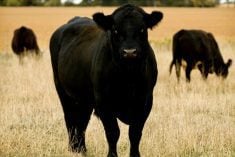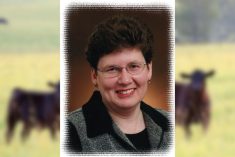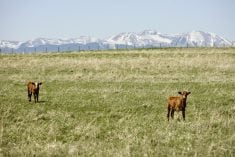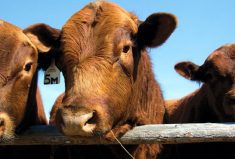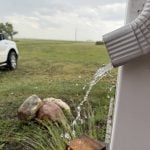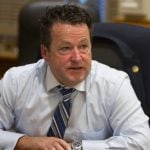Web-enabled cows? Why not, says Mark Thibodeau, an electrical engineer with Krimar Enterprises at Sackville, Nova Scotia. Krimar recently received a licence to develop Directional Virtual Fencing (DVF) patented by the USDA.
Thibodeau says the idea for remote-controlled cows first occurred to him when he happened to drive by a herd grazing in a pasture. But a web search revealed there were people already working on this concept — a group in Australia and Dr. Dean Anderson, an animal scientist with USDA’s agricultural research unit at the expansive Jornada Experimental Range in New Mexico.
Read Also

Drought preparation is better than reaction
Glacier FarmMedia – When it comes to drought, imagining the worst may be the best way to start planning for…
Anderson had already designed a prototype and carried out the scientific research to prove the concept. Thibodeau’s company now has the licence to turn that patented technology into a reality using a rugged GPS (global positioning satellite) unit. In April, he was still in the early stages of securing funding to commercialize this new age fence.
DVF is a way to control grazing without having to pound posts, roll out wire, or physically herd animals from paddock to paddock.
There are three parts to this system: the management unit, a base station, and electronic GPS units worn by the cattle.
The management unit is composed of the DVF management software, a wireless adapter for your laptop and satellite imagery of your pastures. You just draw fence lines on the map where you want them to be in the real pasture. The unit then transmits these fence co-ordinates to the cattle units.
The base station, a portable, solar-powered electronic unit in the pasture, receives the fencing coordinates wirelessly from your laptop, when its within range.
The ideal location for the base station is where the cattle frequent, such as a watering or mineral station. Updated instructions are passed onto the GPS units on the cows each time they go for a drink or some mineral. The units communicate with each other so whenever one unit is updated the tramission quickly spreads to the others operating in the herd. Initially the plan is to put units only on a few lead cows and count on them to influence the rest of the animals.
The halter unit contains a solar-powered receiver/ transmitter plus audio and electric stimulators. When a fitted up cow wanders near a virtual fence, the device produces a discouraging sound in the ear nearest the fence. It can be programmed to deliver a soft audio signal at a certain distance and increase the intensity until
the cow responds and heads back the other way. If she doesn’t respond, an electrical stimulus is delivered.
“Because virtual fencing relies on modifying animal behaviour, boundaries may be leaky,” Thibodeau explains. “It’s not recommended if lack of total control of animals would jeopardize the health or safety of humans or other animals.”
DVF is designed for situations where traditional fencing would be cost prohibitive, or impossible.
Cross-fencing vast expanses of grassland could be achieved by periodically adjusting the fencing coordinates to move cattle across the range. A continuously-moving virtual fence is a future feature that will regularly transmit new co-ordinates to control the direction and speed of the shifting fence, Thibodeau says.
Fire control on native grasslands is an issue for land managers who don’t have cattle. DVF makes it possible to bring in a herd on a temporary basis without installing fences that could pose a danger to people and other animals using the area.
DVF will have the same advantages in rocky and forested regions, perhaps allowing ranchers to utilize remote areas that couldn’t be grazed previously, he adds.
On tame pastures and for intensive grazing systems, DVF would offer the convenience of controlling pasture size and stocking density to achieve the best pasture and stockpiled forage utilization without having to put up cross fences and be there to rotate the cattle. Grazing crop residue on unfenced fields may be more feasible with DVF than having to set up miles of temporary fence.
Some situations could call for keeping cattle out of certain areas at specifitimes of the year, for example, riparian areas, or wildlife breeding and calving grounds.
DVF would also allow a grazier to respond to weather conditions as they happen without having to round up cattle. For instance, you may want to direct cattle out of a low-lying area during periods of heavy rainfall, or closer to home in the event of a snowstorm.
Beyond the time and labour-saving element — there’s no possibility of a tree falling on a virtual fence, brush grounding it out, or wildlife and snow loads taking it down. As a result, there should be less stress on you and your animals.
For more information, contact Thibodeau by e-mail at
the cow responds and heads back the other way. If she doesn’t respond, an electrical stimulus is delivered.
“Because virtual fencing relies on modifying animal behaviour, boundaries may be leaky,” Thibodeau explains. “It’s not recommended if lack of total control of animals would jeopardize the health or safety of humans or other animals.”
DVF is designed for situations where traditional fencing would be cost prohibitive, or impossible.
Cross-fencing vast expanses of grassland could be achieved by periodically adjusting the fencing coordinates to move cattle across the range. A continuously-moving virtual fence is a future feature that will regularly transmit new co-ordinates to control the direction and speed of the shifting fence, Thibodeau says.
Fire control on native grasslands is an issue for land managers who don’t have cattle. DVF makes it possible to bring in a herd on a temporary basis without installing fences that could pose a danger to people and other animals using the area.
DVF will have the same advantages in rocky and forested regions, perhaps allowing ranchers to utilize remote areas that couldn’t be grazed previously, he adds.
On tame pastures and for intensive grazing systems, DVF would offer the convenience of controlling pasture size and stocking density to achieve the best pasture and stockpiled forage utilization without having to put up cross fences and be there to rotate the cattle. Grazing crop residue on unfenced fields may be more feasible with DVF than having to set up miles of temporary fence.
Some situations could call for keeping cattle out of certain areas at specifitimes of the year, for example, riparian areas, or wildlife breeding and calving grounds.
DVF would also allow a grazier to respond to weather conditions as they happen without having to round up cattle. For instance, you may want to direct cattle out of a low-lying area during periods of heavy rainfall, or closer to home in the event of a snowstorm.
Beyond the time and labour-saving element — there’s no possibility of a tree falling on a virtual fence, brush grounding it out, or wildlife and snow loads taking it down. As a result, there should be less stress on you and your animals.
For more information, contact Thibodeau by e-mail at info.krimar.ca.



